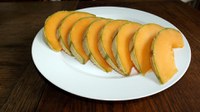Prairie Fare: Take Some Food Safety Precautions With Cantaloupe
(Click an image below to view a high-resolution image that can be downloaded)
By Julie Garden-Robinson, Food and Nutrition Specialist
NDSU Extension
“Just get it started and it will practically roll out of its skin,” the man doing the knife demonstration assured his audience.
I was thinking about those knife ads from years ago. The knives cut through tin cans and shoe leather, then through ripe tomatoes, making slices so thin “your relatives will never come back” (or something like that).
A cantaloupe wouldn’t have given that TV chef with the super-sharp knife a problem.
My husband walked into the kitchen as I attempted to perform surgery on a cantaloupe. I had rinsed and scrubbed the cantaloupe, so I was ready for cutting.
“Be careful,” he said. “Don’t cut yourself.”
If I had cut myself, he might have been driving me to the emergency room. Perhaps a knife safety column would have resulted, typed with a bandaged hand.
Fortunately, I changed my game plan and didn’t cut myself. My cantaloupe wasn’t quite ripe and my knife wasn’t exactly sharp.
I grabbed another knife. I cut the cantaloupe in half from top to bottom, scooped out the seeds, sliced it into wedges, trimmed off the rind and cut the chunks. All 10 of my fingers remain fully functional, by the way.
Cantaloupes and other melons are coming into season. Unfortunately, cantaloupe has been linked to foodborne illness outbreaks, and the food safety issues can occur anywhere along the path from growing to processing to storage to your own kitchen.
Cantaloupes have a netted skin that can trap bacteria. Cantaloupes are grown on the soil, so they can become contaminated by whatever is on the soil, or by the hands of workers who pick the fruit, or by numerous other issues.
In June 2018, the Centers for Disease Control and Prevention (CDC) reported a five-state foodborne illness outbreak associated with precut melon. People who have a salmonella infection may experience flulike symptoms such as diarrhea and fever that appear 12 to 72 hours after eating the food and may last a week.
The dehydration that can result from salmonellosis (the illness caused by the salmonella bacteria) is especially dangerous for vulnerable populations such as young children, older adults and those with weakened immune systems.
Although we may associate salmonella with foods such as eggs and chicken, many outbreaks have been linked with cantaloupe and other melons in the last two decades. Every year, an estimated 1.2 million illnesses and 450 deaths from salmonellosis are associated with many different foods, according to the CDC.
Does this mean we should avoid melon? Don’t give up on the enjoyment of naturally sweet, juicy melon. Not only is it hydrating, but cantaloupe also is an excellent source of C, A, K and B vitamins, plus fiber and many other nutrients. It also provides heart-healthy potassium and fiber.
As with any food, we need to take some precautions, including paying attention to food recalls. The Food and Drug Administration posts them on its website (https://www.fda.gov). You also might want to start with whole melons, then clean and cut at home. More outbreaks have been associated with precut fruit.
When choosing a cantaloupe at a grocery store, look for a melon that is heavy, compared with its size, and one that is not bruised or decayed. The bruised, soft areas most likely are decayed areas that could harbor bacteria or other organisms that could be transferred to the flesh of the fruit during cutting.
Avoid melons that are punctured. Cantaloupes that are tannish or cream-colored with a webbed pattern are more likely ripe. The stem end should be smooth or slightly indented.
When you are ready to cut melon, begin by washing your hands thoroughly. Use running water to rinse the outside of the cantaloupe and a vegetable brush to clean the rough outer netting. Don’t use soap on melons or other fruits and vegetables.
After you cut produce into chunks or slices, remember that you have increased its ability to spoil. Perishable food should spend no more than two hours at room temperature; if the weather is warm, the safe time at room temperature drops to one hour.
When serving any cut produce, keep it cool by serving the bowl or plate nested on top of a bowl of ice.
Most people like salsa of some type. Here’s a recipe to use your knife skills. It combines the sweetness of cantaloupe with a host of other fresh-from-the-garden flavor sensations, including cilantro, peppers, onions and juicy tomatoes. If you decide to preserve salsa, check out the research-tested, safe recipes available at https://www.ag.ndsu.edu/foodpreservation.
Fresh Cantaloupe Salsa
2 c. cantaloupe, peeled and cut into bite-size chunks
2 c. tomatoes, diced
1/4 c. red onion, chopped
1 to 2 Tbsp. cilantro, chopped (or to taste)
1/4 c. yellow bell pepper, chopped
1 to 2 jalapeno peppers, chopped (or to taste)
2 Tbsp. lemon juice
1/2 tsp. minced garlic
2 tsp. olive oil
Salt and pepper (if desired)
Rinse then prepare fruit and vegetables as directed and place in bowl. Mix lemon juice, garlic and olive oil in bowl and drizzle over top of salsa. Gentle mix and refrigerate for one to two hours before serving.
Makes six servings. Without added salt, each serving has 50 calories, 2 grams (g) fat, 1 g protein, 9 g carbohydrate, 2 g fiber and 10 milligrams sodium.
(Julie Garden-Robinson, Ph.D., R.D., L.R.D., is a North Dakota State University Extension food and nutrition specialist and professor in the Department of Health, Nutrition and Exercise Sciences. Follow her on Twitter @jgardenrobinson)
NDSU Agriculture Communication - July 12, 2018
| Source: | Julie Garden-Robinson, 701-231-7187, julie.garden-robinson@ndsu.edu |
|---|---|
| Editor: | Ellen Crawford, 701-231-5391, ellen.crawford@ndsu.edu |



